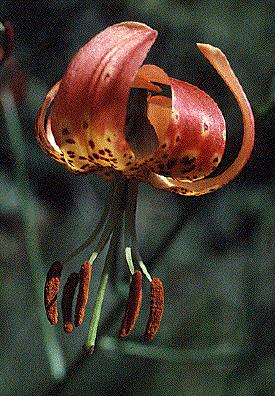







 Like other seed plants, angiosperms are heterosporangiate,
producing pollen and ovules in different organs. Unlike most seed plants,
however, the pollen and ovule-bearing organs are usually produced together
in a bisporangiate strobilus called a flower.
Like other seed plants, angiosperms are heterosporangiate,
producing pollen and ovules in different organs. Unlike most seed plants,
however, the pollen and ovule-bearing organs are usually produced together
in a bisporangiate strobilus called a flower.
In the center of a typical flower are the carpels, modified leaves which enclose the ovules. These are often fused to form a single pistil in the center of the flower. Surrounding the carpels are several narrow stalks topped by pollen sacs; these pollen-bearing stalks are called stamens. Around these reproductive organs is the perianth, usually consisting of an outer whorl of sepals and an inner whorl of petals. In monocots and "primitive" dicots, the sepals and petals may be indistinguishable, as in the lily shown at right. In this case the perianth parts are called tepals.
The first flowering plants had numerous floral parts spiralled around a central axis, much like the flowers of Magnolia. In most angiosperms, however, the floral parts are relatively few, and are arranged in a whorl, in which a set of parts are all attached around the central axis at the same level, instead of being attached in a staggered spiral. The parts of these earliest flowers were likely very large and radially arranged; they were not fused to each other, as is common in many groups today.
In many angiosperms, the flowers are arranged in clusters called inflorescences. The flowers may be attached along a tall stalk, arranged in broad open clusters, or pressed tightly together so that the cluster looks like a single flower.
Angiosperms differ from other seed plants in that they enclose their ovules (and seeds) within a carpel. The carpel is a modified leaf bearing the ovules, but the carpel is folded onto itself, wrapping the ovules inside. The "vessel" which the carpel forms gives the angiosperms their name.
Although the carpels are hypothesized to give extra protection to the developing ovules and seeds, there is a problem with encasing the ovules -- how to get the pollen to the ovule so that it can deliver the sperm? In angiopserms, the pollen tube does not simply grow through an opening in the tissue surrounding the ovule, but it must penetrate and grow through the tissue.
This feature of angiosperms allows for sexual selection and pollen competition in ways that are not possible in other seed plants. The carpel tissue can "screen" arriving pollen, and selectively prevent growth of certain genotypes. In some flowers, this increases outbreeding, as the plant prevents its own pollen from germinating.
Once the pollen has fertilized the egg cell contained within the ovule, the ovule develops into a seed, and the ovary of the enclosing carpel begins to enlarge and ripen, forming the fruit. This is the botanical definition of a fruit, and is not the same as the popular usage of "fruit". For example, a botanist considers acorns, tomatoes, green beans, and coconuts to be fruits. The individual grains of wheat and rice are also fruits by this definition. By contrast, strawberries are NOT fruits; the individual hard bits on the outside of the strawberry are the matured ovaries, and are properly considered fruits, while the fleshy red portion is actually stem tissue stimulated to growth by the maturing fruits.
It should also be pointed out that ALL flowering plants produce fruits, and that not all fruits are edible. The fruit of the potato plant is quite poisonous, and should not be eaten. Cotton bolls are dry fruits from which we harvest cotton fibers.
You can read about the morphological differences between monocots and dicots on our server.
California State University has an online interactive Fruit Key with illustrations.
Learn How to Identify Flowering Plants from Botany Online.

Source:
E.M.Gifford and A.S.Foster. 1989. Morphology and Evolution of Vascular
Plants, 3rd ed. W.H.Freeman and Company, New York.

